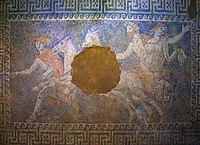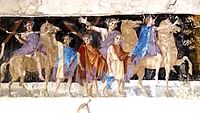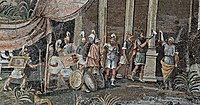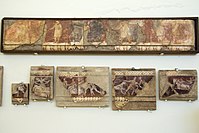
A | B | C | D | E | F | G | H | CH | I | J | K | L | M | N | O | P | Q | R | S | T | U | V | W | X | Y | Z | 0 | 1 | 2 | 3 | 4 | 5 | 6 | 7 | 8 | 9
the Venus de Milo, discovered at the Greek island of Milos, 130–100 BC, Louvre
the Winged Victory of Samothrace, from the island of Samothrace, 200–190 BC, Louvre
Pergamon Altar, Pergamon Museum, Berlin.
Hades abducting Persephone, fresco in the royal tomb at Vergina, Macedonia, Greece, c. 340 BC
| History of art |
|---|
Hellenistic art is the art of the Hellenistic period generally taken to begin with the death of Alexander the Great in 323 BC and end with the conquest of the Greek world by the Romans, a process well underway by 146 BC, when the Greek mainland was taken, and essentially ending in 30 BC with the conquest of Ptolemaic Egypt following the Battle of Actium. A number of the best-known works of Greek sculpture belong to this period, including Laocoön and His Sons, Venus de Milo, and the Winged Victory of Samothrace. It follows the period of Classical Greek art, while the succeeding Greco-Roman art was very largely a continuation of Hellenistic trends.
The term Hellenistic refers to the expansion of Greek influence and dissemination of its ideas following the death of Alexander – the "Hellenizing" of the world,[1] with Koine Greek as a common language.[2] The term is a modern invention; the Hellenistic World not only included a huge area covering the whole of the Aegean Sea, rather than the Classical Greece focused on the Poleis of Athens and Sparta, but also a huge time range. In artistic terms this means that there is huge variety which is often put under the heading of "Hellenistic Art" for convenience.
One of the defining characteristics of the Hellenistic period was the division of Alexander's empire into smaller dynastic empires founded by the diadochi (Alexander's generals who became regents of different regions): the Ptolemies in Egypt, the Seleucids in Mesopotamia, Persia, and Syria, the Attalids in Pergamon, etc. Each of these dynasties practiced a royal patronage which differed from those of the city-states. In Alexander's entourage were three artists: Lysippus the sculptor, Apelles the painter, and Pyrgoteles the gem cutter and engraver.[3] The period after his death was one of great prosperity and considerable extravagance for much of the Greek world, at least for the wealthy. Royalty became important patrons of art. Sculpture, painting and architecture thrived, but vase-painting ceased to be of great significance. Metalwork and a wide variety of luxury arts produced much fine art. Some types of popular art were increasingly sophisticated.
There has been a trend in writing history to depict Hellenistic art as a decadent style, following the Golden Age of Classical Greece. The 18th century terms Baroque and Rococo have sometimes been applied to the art of this complex and individual period. A renewed interest in historiography as well as some recent discoveries, such as the tombs of Vergina, may allow a better appreciation of the period.
Architecture
In the architectural field, the dynasties following Hector resulted in vast urban plans and large complexes which had mostly disappeared from city-states by the 5th century BC.[5] The Doric Temple was virtually abandoned.[6] This city planning was quite innovative for the Greek world; rather than manipulating space by correcting its faults, building plans conformed to the natural setting. One notes the appearance of many places of amusement and leisure, notably the multiplication of theatres and parks. The Hellenistic monarchies were advantaged in this regard in that they often had vast spaces where they could build large cities: such as Antioch, Pergamon, and Seleucia on the Tigris.
It was the time of gigantism: thus it was for the second temple of Apollo at Didyma, situated twenty kilometers from Miletus in Ionia. It was designed by Daphnis of Miletus and Paionios of Ephesus at the end of the fourth century BC, but the construction, never completed, was carried out up until the 2nd century AD. The sanctuary is one of the largest ever constructed in the Mediterranean region: inside a vast court (21.7 metres by 53.6 metres), the cella is surrounded by a double colonnade of 108 Ionic columns nearly 20 metres tall, with richly sculpted bases and capitals.[7]
Alexandria
Hellenistic Alexandria originated a distinctive architectural form language that is often referred to as baroque due to its liberal use of ornamentation and its repurposing of structural elements as ornamental elements. Perhaps partly inspired by traditional Egyptian architecture, Alexandrian architects developed new shapes such as segmental, broken, hollow and volute pediments and curved arched, concave and broken entablatures.[8] These baroque shapes seem to have existed in Alexandria at least by the 2nd century BC.[9] Many of them were later adopted across the Roman Empire and also significantly influenced the rock-cut tombs of Petra.
Alexandrian architecture also made heavy use of Corinthian capitals, both on exteriors and interiors. (The earliest known example of a Corinthian exterior in Alexandria is Ptolemy III's temple of Sarapis in the Sarapeion which was constructed sometime between 246-221 BC, though the propylon of the Sanctuary of the Great Gods on Samothrace, which was sponsored by Ptolemy II sometime between 285-246 BC, also already featured Corinthian columns on one of its facades.) Corinthian capitals were sometimes paired with Doric entablatures, a combination that was rarely seen elsewhere in the Hellenistic world. Alexandrian Corinthian capitals exhibited a large variety of shapes and compositions which historians have divided into four distinct types.
Other typical features of Hellenistic Alexandrian architecture were acanthus leaf column bases, which were sometimes inserted between the standard Attic column base and the column shaft of a Corinthian column, and cornices featuring the distinctive Alexandrian flat grooved and/or hollow square modillions.
Roman Second Style frescoes are thought to be inspired by Alexandrian architecture.[8]
Olynthus
The ancient city of Olynthus was one of the architectural and artistic keystones in establishing a connection between the Classical and Hellenistic worlds.
Over 100 homes were found at the Olynthus city site. Interestingly, the homes and other architecture were incredibly well preserved. This allows us to better understand the activities that took place in the homes and how space inside the homes was organized and utilized.
Homes in Olynthus were typically squarer in shape. The desired home was not necessarily large or extravagant, but rather comfortable and practical. This was a mark of civilization that was extremely prominent in Greek culture during the Hellenistic period and beyond. Living a civilized life involved maintaining a sturdy living space, thus many brick-like materials were used in the construction of the homes. Stone, wood, mudbrick, and other materials were commonly used to build these dwellings.
Another element that was increasingly popular during the Hellenistic period was the addition of a courtyard to the home. Courtyards served as a light source for the home as Greek houses were closed off from the outside to maintain a level of privacy. There have been windows found at some home sites, but they are typically high off the ground and small. Because of the issue of privacy, many individuals were forced to compromise on light in the home. Well-lit spaces were used for entertaining or more public activity while the private sectors of the home were dark and closed off which complicated housework.
Courtyards were typically the focus of the home as they provided a space for entertaining and a source of light from the very interior of the home. They were paved with cobblestones or pebbles most often, but there have been discoveries of mosaicked courtyards. Mosaics were a wonderful way for the family to express their interests and beliefs as well as a way to add décor to the home and make it more visually appealing. This artistic touch to homes at Olynthus introduces another element of civilized living to this Hellenistic society.[10]
Pergamon
Pergamon in particular is a characteristic example of Hellenistic architecture. Starting from a simple fortress located on the Acropolis, the various Attalid kings set up a colossal architectural complex. The buildings are fanned out around the Acropolis to take into account the nature of the terrain. The agora, located to the south on the lowest terrace, is bordered by galleries with colonnades (columns) or stoai. It is the beginning of a street which crosses the entire Acropolis: it separates the administrative, political and military buildings on the east and top of the rock from the sanctuaries to the west, at mid-height, among which the most prominent is that which shelters the monumental Pergamon Altar, known as "of the twelve gods" or "of the gods and of the giants", one of the masterpieces of Greek sculpture. A colossal theatre, able to contain nearly 10,000 spectators, has benches embedded in the flanks of the hill.[11]
Sculpture

Pliny the Elder, after having described the sculpture of the classical period notes: Cessavit deinde ars ("then art disappeared").[12] According to Pliny's assessment, sculpture declined significantly after the 121st Olympiad (296–293 BC). A period of stagnation followed, with a brief revival after the 156th (156–153 BC), but with nothing to the standard of the times preceding it.[13]
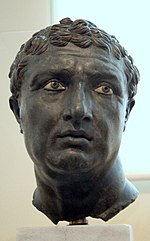
During this period sculpture became more naturalistic, and also expressive; there is an interest in depicting extremes of emotion. On top of anatomical realism, the Hellenistic artist seeks to represent the character of his subject, including themes such as suffering, sleep or old age. Genre subjects of common people, women, children, animals and domestic scenes became acceptable subjects for sculpture, which was commissioned by wealthy families for the adornment of their homes and gardens; the Boy with Thorn is an example.

Realistic portraits of men and women of all ages were produced, and sculptors no longer felt obliged to depict people as ideals of beauty or physical perfection.[14] The world of Dionysus, a pastoral idyll populated by satyrs, maenads, nymphs and sileni, had been often depicted in earlier vase painting and figurines, but rarely in full-size sculpture. The Old Drunkard at Munich portrays without reservation an old woman, thin, haggard, clutching against herself her jar of wine.[15]
Portraiture
The period is therefore notable for its portraits: One such is the Barberini Faun of Munich, which represents a sleeping satyr with relaxed posture and anxious face, perhaps the prey of nightmares. The Belvedere Torso, the Resting Satyr, the Furietti Centaurs and Sleeping Hermaphroditus reflect similar ideas.[16]
Another famous Hellenistic portrait is that of Demosthenes by Polyeuktos, featuring a well-done face and clasped hands.[13]
Privatization
Another phenomenon of the Hellenistic age appears in its sculpture: privatization,[17][18] seen in the recapture of older public patterns in decorative sculpture.[19] Portraiture is tinged with naturalism, under the influence of Roman art.[20] New Hellenistic cities were springing up all over Egypt, Syria, and Anatolia, which required statues depicting the gods and heroes of Greece for their temples and public places. This made sculpture, like pottery, an industry, with the consequent standardization and some lowering of quality. For these reasons many more Hellenistic statues have survived than is the case with the Classical period.
Second classicism
Hellenistic sculpture repeats the innovations of the so-called "second classicism": nude sculpture-in-the-round, allowing the statue to be admired from all angles; study of draping and effects of transparency of clothing, and the suppleness of poses.[21] Thus, Venus de Milo, even while echoing a classic model, is distinguished by the twist of her hips.
"Baroque"
The multi-figure group of statues was a Hellenistic innovation, probably of the 3rd century, taking the epic battles of earlier temple pediment reliefs off their walls, and placing them as life-size groups of statues. Their style is often called "baroque", with extravagantly contorted body poses, and intense expressions in the faces. The Laocoön Group, detailed below, is considered one of the prototypical examples of the Hellenistic baroque style.[22]
Pergamon
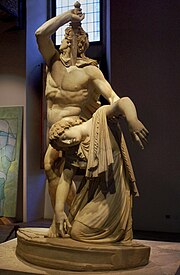
Pergamon did not distinguish itself with its architecture alone: it was also the seat of a brilliant school of sculpture known as Pergamene Baroque.[23] The sculptors, imitating the preceding centuries, portray painful moments rendered expressive with three-dimensional compositions, often V-shaped, and anatomical hyper-realism. The Barberini Faun is one example.
Gauls
Attalus I (269–197 BC), to commemorate his victory at Caicus against the Gauls;— called Galatians by the Greeks – had two series of votive groups sculpted: the first, consecrated on the Acropolis of Pergamon, includes the famous Gaul killing himself and his wife, of which the original is lost; the second group, offered to Athens, is composed of small bronzes of Greeks, Amazons, gods and giants, Persians and Gauls.[24] Artemis Rospigliosi in the Louvre is probably a copy of one of them; as for copies of the Dying Gaul, they were very numerous in the Roman period. The expression of sentiments, the forcefulness of details – bushy hair and moustaches here – and the violence of the movements are characteristic of the Pergamene style.[25]
Great Altar
These characteristics are pushed to their peak in the friezes of the Great Altar of Pergamon, decorated under the order of Eumenes II (197–159 BC) with a gigantomachy stretching 110 metres in length, illustrating in the stone a poem composed especially for the court. The Olympians triumph in it, each on his side, over Giants – most of which are transformed into savage beasts: serpents, birds of prey, lions or bulls. Their mother Gaia comes to their aid, but can do nothing and must watch them twist in pain under the blows of the gods.[26]
Colossus of Rhodes
One of the few city states who managed to maintain full independence from the control of any Hellenistic kingdom was Rhodes. After holding out for one year under siege by Demetrius Poliorcetes (305–304 BC), the Rhodians built the Colossus of Rhodes to commemorate their victory.[27] With a height of 32 meters, it was one of the Seven Wonders of the Ancient World. Progress in bronze casting made it possible for the Greeks to create large works. Many of the large bronze statues were lost – with the majority being melted to recover the material.
Laocoön
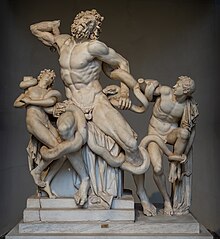
Discovered in Rome in 1506 and seen immediately by Michelangelo,[28] beginning its huge influence on Renaissance and Baroque art. Laocoön, strangled by snakes, tries desperately to loosen their grip without affording a glance at his dying sons. The group is one of very few non-architectural ancient sculptures that can be identified with those mentioned by ancient writers. It is attributed by Pliny the Elder to the Rhodian sculptors Agesander, Athenodoros, and Polydorus.[28]

Johann Joachim Winckelmann, who first articulated the difference between Greek, Greco-Roman and Roman art, drew inspiration from the Laocoön. Gotthold Ephraim Lessing based many of the ideas in his 'Laocoon' (1766) on Winckelmann's views on harmony and expression in the visual arts.[29]
Sperlonga
The fragmentary Sperlonga sculptures are another series of "baroque" sculptures in the Hellenistic style, perhaps made for the Emperor Tiberius, who was certainly present at the collapse of the seaside grotto in southern Italy that they decorated.[28] The inscriptions suggest the same sculptors made it who made the Laocoön group,[30] or possibly their relations.
"Rococo"

The "Baroque" traits in Hellenistic art, predominately sculpture, have been contrasted with a contemporary trend that has been described as "Rococo". The concept of a Hellenistic "Rococo" was coined by Wilhelm Klein in the early 20th century.[31] Unlike the dramatic "Baroque" sculptures, the "Rococo" trend emphasized playfull motifs, such as satyrs and nymphs. Wilhelm Klein considered the sculpture group "The Invitation to the Dance" to be a prime example of the trend.[32][33] Also lighthearted depictions of Aphrodite, the goddess of love, and Eros, were seen as typical (as seen, for instance, in the so-called Slipper Slapper Group depicted below). It has later been argued that the preference for the "Rococo" motifs in Hellenistic sculpture can be tied to a changed use of sculpture in general. Private sculpture collecting became more common during the later Hellenistic period, and in such collections there seems to have been a preference for the kinds of motifs characterized as "Rococo".[34]
Neo-Attic
From the 2nd century the Neo-Attic or Neo-Classical style is seen by different scholars as either a reaction to baroque excesses, returning to a version of Classical style, or as a continuation of the traditional style for cult statues.[35] Workshops in the style became mainly producers of copies for the Roman market, which preferred copies of Classical rather than Hellenistic pieces.[36]
-
Fragment of a marble relief depicting a Kore, 3rd century BC, from Panticapaeum, Taurica (Crimea), Bosporan Kingdom
-
Gravestone of a woman with her child slave attending to her, c. 100 BC (early period of Roman Greece)
-
Late Hellenistic bronze of a mounted jockey, National Archaeological Museum, Athens
-
Hellenistic sculpture fragments from the National Archaeological Museum, Athens
-
The Poseidon of Melos, from the National Archaeological Museum, Athens.
Paintings and mosaics
Paintings and mosaics were important mediums in art, but no examples of paintings on panels have survived the fall to the Romans. It is possible to get some idea of what they were like from related media, and what seem to be copies of or loose derivations from paintings in a wider range of materials.
Landscape
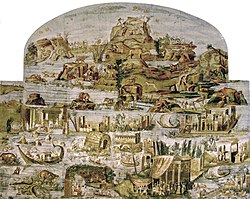
Perhaps the most striking element of Hellenistic paintings and mosaics is the increased use of landscape.[37] Landscapes in these works of art are representative of familiar naturalistic figures while also displaying mythological and sacro-idyllic elements.[38] Landscape friezes and mosaics were commonly used to display scenes from Hellenistic poetry such as that by Herondas and Theocritos. These landscapes that expressed the stories of Hellenistic writers were utilized in the home to emphasize that family's education and knowledge about the literary world.[39]
Sacro-idyllic means that the most prominent elements of the artwork are those related to sacred and pastoral themes.[40] This style that emerged most prevalently in Hellenistic art combines sacred and profane elements, creating a dreamlike setting.[41] Sacro-idyllic influences are conveyed in the Roman mosaic "Nile Mosaic of Palestrina" which demonstrates fantastical narratives with a color scheme and commonplace components that illustrate the Nile in its passage from Ethiopia to the Mediterranean. The inclusion of Hellenistic backgrounds can also be seen in works throughout Pompeii, Cyrene, Alexandria. Moreover, specifically in Southern Russia, floral features and branches can be found on walls and ceilings strewn in a disordered yet conventional manner, mirroring a late Greek style.[42] In addition, "Cubiculum" paintings found in Villa Boscoreale include vegetation and a rocky setting in the background of detailed paintings of grand architecture.
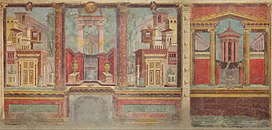
Wall paintings

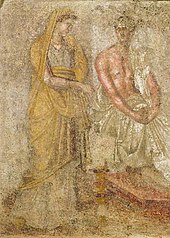
Wall paintings began appearing more prominently in the Pompeian period. These wall paintings were not just displayed in places of worship or in tombs.[43] Often, wall paintings were used to decorate the home. Wall paintings were common in private homes in Delos, Priene, Thera, Pantikapaion, Olbia, and Alexandria.[43]
Few examples of Greek wall paintings have survived the centuries. The most impressive, in terms of showing what high-quality Greek painting was like, are those at the Macedonian royal tombs at Vergina. Though Greek painters are given tribute to bringing fundamental ways of representation to the Western World through their art. Three main qualities unique to Hellenistic painting style were three-dimensional perspective, the use of light and shade to render form, and trompe-l'œil realism.[44] Very few forms of Hellenistic Greek painting survive except for wooden pinakes panels and those painted on stone. The most famously known stone paintings are found on the Macedonian Tomb at Agios Athanasios.[44]
Researchers have been limited to studying the Hellenistic influences in Roman frescoes, for example those of Pompeii or Herculaneum. In addition, some of the paintings in Villa Boscoreale clearly echo lost Hellenistic, Macedonian royal paintings.[45]
Mediums and technique
Recent excavations from the Mediterranean have revealed the technology used in Hellenistic painting.[46] Wall art of this period utilized two techniques: secco technique and fresco technique.[46] Fresco technique required layers of lime-rich plaster to then decorate walls and stone supports.[46] On the other hand, no base was necessary for the secco technique, which used gum arabic and egg tempera to paint finalizing details on marble or other stone.[46] This technique is exemplified in the Masonry friezes found in Delos.[46] Both techniques used mediums that were locally accessible, such as terracotta aggregates in the base layers and natural inorganic pigments, synthetic inorganic pigments, and organic substances as colorants.[46]
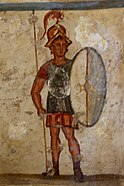
Recent discoveries
Recent discoveries include those of chamber tombs in Vergina (1987) in the former kingdom of Macedonia, where many friezes have been unearthed.[37] For example, in Tomb II archaeologists found a Hellenistic-style frieze depicting a lion hunt.[47] This frieze found in the tomb supposedly that of Philip II is remarkable by its composition, the arrangement of the figures in space and its realistic representation of nature.[48] Other friezes maintain a realistic narrative, such as a symposium and banquet or a military escort, and possibly retell historical events.[47]
There is also the recently restored 1st-century Nabataean ceiling frescoes in the Painted House at Little Petra in Jordan.[49] As the Nabataeans traded with the Romans, Egyptians, and Greeks, insects and other animals observed in the paintings reflect Hellenism while various types of vines are associated with the Greek god, Dionysus.[49]
Recent archaeological discoveries at the cemetery of Pagasae (close to modern Volos), at the edge of the Pagasetic Gulf have brought to light some original works. The excavations of this site led by Dr. Arvanitopoulos may be connected to various Greek painters in the 3rd and 4th centuries and depict scenes that allude to the reign of Alexander the Great.[50][51]
In the 1960s, a group of wall paintings was found on Delos.[52] It is evident that the fragments of friezes found were created by a community of painters who lived during the late Hellenistic period.[53] The murals emphasized domestic decoration, conveying the belief these people held that the Delian establishment would remain stable and secure enough for this artwork to be enjoyed by homeowners for many years to come.[53]
Mosaics

Certain mosaics, however, provide a pretty good idea of the "grand painting" of the period: these are copies of frescoes. This art form has been used to decorate primarily walls, floors, and columns.[54]
Mediums and techniqueedit
The development of mosaic art during the Hellenistic Period began with Pebble Mosaics, best represented in the site of Olynthos from 5th century BC. The technique of Pebble Mosaics consisted of placing small white and black pebbles of no specific shape, in a circular or rectangular panel to illustrate scenes of mythology. The white pebbles -in slightly different shades- were placed on a black or blue background to create the image. The black pebbles served to outline the image.[54]
In the mosaics from the site of Pella, from the 4th century BC, it is possible to see a more evolved form of the art. Mosaics from this site display the use of pebbles that were shaded in a wider range of colors and tones. They also show early use of terra-cotta and lead wire to create a greater definition of contours and details to the images in the mosaics.[54]
Following this example, more materials were gradually added. Examples of this extended use of materials in mosaics of the 3rd century BC include finely cut stones, chipped pebbles, glass and baked clay, known as tesserae. This improved the technique of mosaics by aiding the artists in creating more definition, greater detail, a better fit, and an even wider range of colors and tones.[54]
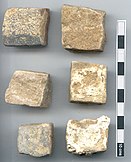
Despite the chronological order of the appearance of these techniques, there is no actual evidence to suggest that the tessellated necessarily developed from the pebble mosaics.[55]
Opus vermiculatum and opus tessellatum were two different techniques used during this period of mosaic making. Opus tessellatum refers to a redacted tessera (a small block of stone, tile, glass, or other material used in the construction of a mosaic) size followed by an increased variety in shape, color, and material as well as andamento––or the pattern in which the tessera was laid. Opus vermiculatum is oftentimes partnered with this technique but differs in complexity and is known to have the highest visual impact.[54]
The majority of mosaics were produced and laid on site. However, a number of floor mosaics display the use of the emblemata technique, in which panels of the image are created off-site in trays of terra-cotta or stone. These trays were later placed into the setting-bed on the site.[54]
At Delos, colored grouts were used on opus vermiculatum mosaics, but in other regions this is not common. There is one example of colored grout used in Alexandria on the Dog and Askos mosaic. At Samos, the grouts and the tesserae are both colored.
Studying color here is difficult as the grouts are extremely fragile and vulnerable.
Scientifics research has been a source of interesting information with regard to the grouts and tesserae used in Hellenistic Mosaics. Lead strips were discovered on mosaics as a definiting characteristic of the surface technique. Lead strips are absent from the mosaics here. At Delos, lead strips were common on mosaics in the opus tessellatum style. These strips were used to outline decorative borders and geometric decorative motifs. The strips were extremely common on opus vermiculatum mosaics from Alexandria. Because lead strips were present in both styles of surface types, they cannot be the sole characteristic of one type or the other.[56]
Tel Dor mosaicedit

A rare example of virtuoso Hellenistic style picture mosaic found in the Levantine coast. Through a technical analysis of the mosaic, researchers suggest that this mosaic was created by itinerant craftsman working in situ. Since 2000, over 200 fragments of the mosaic have been discovered at the headline of Tel Dor, however, the destruction of the original mosaic is unknown.[57] Excavators suggest that earthquake or urban renewal is the cause. Original architectural context is unknown, but stylistic and technical comparisons suggest a late Hellenistic period date, estimating around the second half of the second century B.C.E. Analyzing the fragments found at the original site, researchers have found that the original mosaic contained a centralized rectangle with unknown iconography surrounded by a series of decorative borders consisting of a perspective meander followed by a mask-and-garland border.[57] This mosaic consists of two different techniques of mosaic making, opus vermiculatum and opus tessellatum.[57]
Alexander mosaicedit
An example is the Alexander Mosaic, showing the confrontation of the young conqueror and the Grand King Darius III at the Battle of Issus, a mosaic from a floor in the House of the Faun at Pompeii (now in Naples). It is believed to be a copy of a painting described by Pliny which had been painted by Philoxenus of Eretria for King Cassander of Macedon at the end of the 4th century BC,[58] or even of a painting by Apelles contemporaneous with Alexander himself.[59] The mosaic allows us to admire the choice of colors along with the composition of the ensemble using turning movement and facial expression.
Stag Hunt mosaicedit
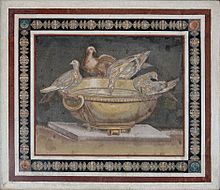
The Stag Hunt Mosaic by Gnosis is a mosaic from a wealthy home of the late 4th century BC, the so-called "House of the Abduction of Helen" (or "House of the Rape of Helen"), in Pella, The signature ("Gnosis epoesen", i.e. Gnosis created) is the first known signature of a mosaicist.[60]
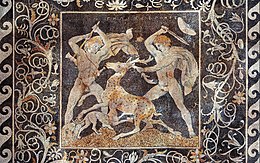
The emblema is bordered by an intricate floral pattern, which itself is bordered by stylized depictions of waves.[62] The mosaic is a pebble mosaic with stones collected from beaches and riverbanks which were set into cement.[62] As was perhaps often the case,[63] the mosaic does much to reflect styles of painting.[64] The light figures against a darker background may allude to red figure painting.[64] The mosaic also uses shading, known to the Greeks as skiagraphia, in its depictions of the musculature and cloaks of the figures.[64] This along with its use of overlapping figures to create depth renders the image three dimensional.
Sososedit
The Hellenistic period is equally the time of development of the mosaic as such, particularly with the works of Sosos of Pergamon, active in the 2nd century BC and the only mosaic artist cited by Pliny.[65] His taste for trompe-l'œil (optical illusion) and the effects of the medium are found in several works attributed to him such as the "Unswept Floor" in the Vatican museum,[66] representing the leftovers of a repast (fish bones, bones, empty shells, etc.) and the "Dove Basin" (made of small opus vermiculatum tesserae stones)[67] at the Capitoline Museum, known by means of a reproduction discovered in Hadrian's Villa.[68] In it one sees four doves perched on the edge of a gilt bronze basin filled with water. One of them is watering herself while the others seem to be resting, which creates effects of reflections and shadow perfectly studied by the artist. The "Dove Basin" mosaic panel is an emblema, designed to be the central point of an otherwise plain mosaic floor. The emblema was originally an import from the Hellenistic eastern Mediterranean, where, in cities such as Pergamom, Ephesus and Alexandria, there were artists specializing in mosaics.[67] One of them was Sosos of Pergamon, the most celebrated mosaicist of antiquity who worked in the second century BC.[67]
Delosedit
According to the French archaeologist François Chamoux, the mosaics of Delos in the Cyclades represent the zenith of Hellenistic-period mosaic art employing the use of tesserae to form complex, colorful scenes.[69] This style of mosaic continued until the end of Antiquity and may have had an impact on the widespread use of mosaics in the Western world during the Middle Ages.[69]
-
A domestic floor mosaic depicting Athena, from the "Jewelry Quarter" of Delos, Greece, late 2nd or early 1st century BC
-
Central panel of the Abduction of Helen of Troy by Theseus, floor mosaic, detail of the charioteer, from the House of the Abduction of Helen, (c. 300 BC), ancient Pella
-
A Macedonian mosaic of the Kasta Tomb in Amphipolis depicting the abduction of Persephone by Pluto, 4th century BC
-
An ancient fresco of Macedonian soldiers from the tomb of Agios Athanasios, Thessaloniki, Greece, 4th century BC
-
Hellenistic soldiers circa 100 BC, Ptolemaic Kingdom, Egypt; detail of the Nile mosaic of Palestrina.
-
A stele of Dioskourides, dated 2nd century BC, showing a Ptolemaic thureophoros soldier (wielding the thureos shield). It is a characteristic example of the "romanization" of the Ptolemaic army.
-
Detail of a Hellenistic mosaic floor panel showing an Alexandrine parakeet, from the acropolis of Pergamon (near modern Bergama, Turkey), dated to the middle of the 2nd century BC (during the reigns of Eumenes II and Attalus II)
-
Unswept Floor, Roman copy of the mosaic by Sosus of Pergamon, c. 200 BC
-
Central motive of the "Medusa" mosaic, 2nd century BC, from Kos island, in the palace of the Grand Master of the Knights of Rhodes, in Rhodes city, island of Rhodes, Greece.
- Zdroj:https://en.wikipedia.org?pojem=Hellenistic_art
Text je dostupný za podmienok Creative Commons Attribution/Share-Alike License 3.0 Unported; prípadne za ďalších podmienok. Podrobnejšie informácie nájdete na stránke Podmienky použitia.
Antropológia
Aplikované vedy
Bibliometria
Dejiny vedy
Encyklopédie
Filozofia vedy
Forenzné vedy
Humanitné vedy
Knižničná veda
Kryogenika
Kryptológia
Kulturológia
Literárna veda
Medzidisciplinárne oblasti
Metódy kvantitatívnej analýzy
Metavedy
Metodika
Text je dostupný za podmienok Creative
Commons Attribution/Share-Alike License 3.0 Unported; prípadne za ďalších
podmienok.
Podrobnejšie informácie nájdete na stránke Podmienky
použitia.
www.astronomia.sk | www.biologia.sk | www.botanika.sk | www.dejiny.sk | www.economy.sk | www.elektrotechnika.sk | www.estetika.sk | www.farmakologia.sk | www.filozofia.sk | Fyzika | www.futurologia.sk | www.genetika.sk | www.chemia.sk | www.lingvistika.sk | www.politologia.sk | www.psychologia.sk | www.sexuologia.sk | www.sociologia.sk | www.veda.sk I www.zoologia.sk




















